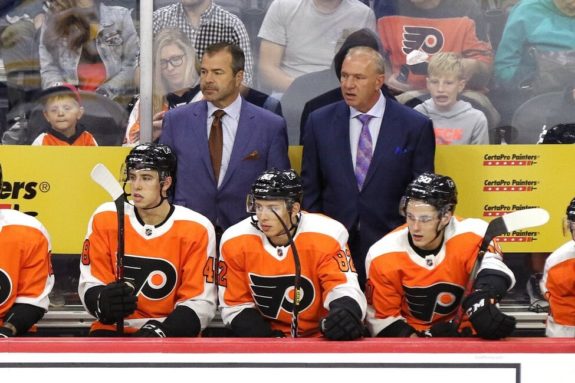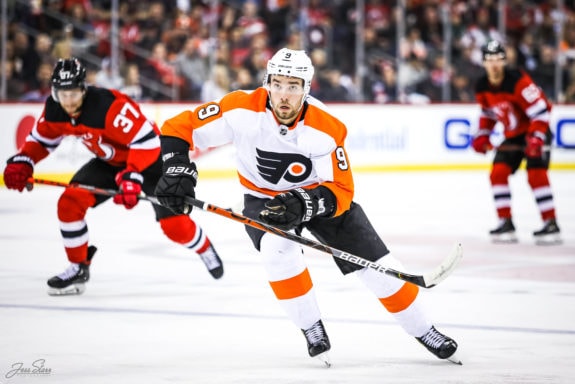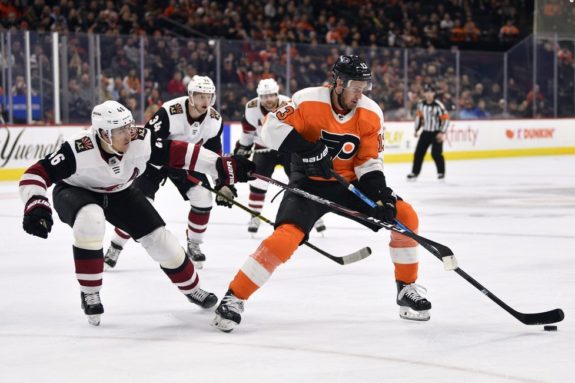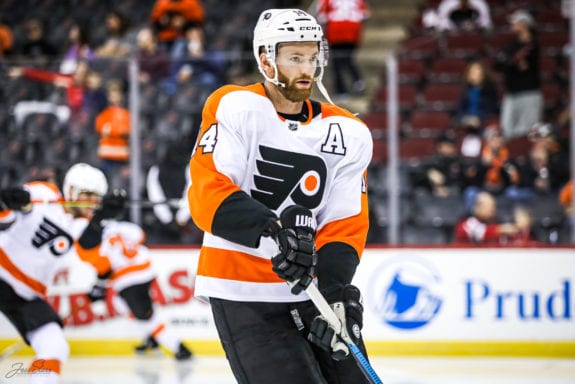With just over a fifth of the season left to play, the Philadelphia Flyers have the league’s 11th-best power play. They have scored on 21.6 percent of their power play opportunities, a noticeable improvement from last season when the Flyers possessed a 17.1 power-play percentage, good for 22nd in the NHL.
There are a few factors which help explain why the Flyers’ power play has improved so much:
New Coaching Staff
I would be remiss to not first give some credit to those who have masterminded this very improvement.
For the 2019-20 season, general manager Chuck Fletcher ushered in a new regime behind the bench. First, he hired Alain Vigneault as head coach. Then, the two of them brought in former NHL head coaches Mike Yeo and Michel Therrien to lead the Flyers’ special teams units. Yeo leads the penalty kill (a unit which has had its own improvements), while Therrien oversees the power play.

Therrien has brought not only nearly 30 years of hockey coaching experience but also a new philosophy to the Flyers’ power play.
The philosophy is that Therrien expects the same intensity from both of his power-play units and refuses to call either of them the first or second unit (from ‘Flyers’ power play thriving under new assistant coach Michel Therrien | Sam Carchidi,’ Philadelphia Inquirer, 10/29/2019). He preaches aggressiveness and getting pucks towards the net from both units.
Related: Pennsylvania Hockey – A Long, Proud History
Therrien has to be happy with the results so far, as his power-play units have combined for 46 goals. That total has already surpassed the 40 goals scored by the Kris Knoblauch-coached Flyer power play last season.
More Power Play Opportunities
Practice makes perfect, so of course, the Flyers would benefit from having more chances to work on the power play. Fortunately, those chances have been abundant this season.
Through 65 games, the Flyers have had 213 power-play opportunities, the fourth-most in the NHL. This comes out to an average of over three power-play opportunities per game. With that many opportunities, the Flyers can often, within each game, analyze the strengths and weaknesses of their power-play units and find ways to improve.
Related: Flyers Add Depth With Thompson
In comparison, the Flyers had 234 power plays in all of last season. That was just 18th most in the league.
Key Additions to the Power Play
The first addition was not really an addition at all, as defenseman Ivan Provorov was on the Flyers last season. Nonetheless, with defenseman Shayne Gostisbehere healthy for most of last season, Provorov mostly played on the second power-play unit. As a result, Provorov’s average power-play ice time last season was just 1:33 per game.
This season, with Gostisbehere currently injured, Provorov has taken over as the point man on the “top” power-play unit. His average power-play ice time has almost doubled to 3:00 per game.

Provorov has taken advantage of this increased role, as he is tied for the team lead with seven power-play goals. He did not score a single power-play goal last season while on the second unit.
One could argue that Provorov is better-suited for his new role than was Gostisbehere, as Gostisbehere scored just four power-play goals last season.
While Provorov has thrived in his new role, the Flyers also brought in a couple of actual additions to improve the power play. The offseason acquisitions of Kevin Hayes and Matt Niskanen have led to a significant boost in production from what would traditionally be referred to as the second power-play unit.

Both of these players have scored four power-play goals this season. Together they have scored almost 20 percent of the Flyers’ power-play goals this season.
Dominance at the Faceoff Dot
It is crucial to win faceoffs, especially while on the power play. This allows the team that is on the power play to keep the puck in the offensive zone and makes it much more difficult for the shorthanded team to kill the penalty.
The Flyers have excelled at faceoffs this year. They lead the NHL with a 54.5 faceoff win percentage. Much credit goes to Sean Couturier and Claude Giroux, both on the “top” power-play unit. Each player has won over 59 percent of their faceoffs so far.

Nonetheless, faceoff success by itself is a tenuous explanation for the improved power play. The reason is that last year, the Flyers also led the NHL in faceoff win percentage, yet their power play was not very good.
Still, the power-play units benefit from success at the faceoff dot. And when this factor is combined with the new coaching staff, increased power play opportunities and key additions to the power play, it is little surprise that the Flyers have improved so much on the power play.
All statistics came from Hockey Reference.